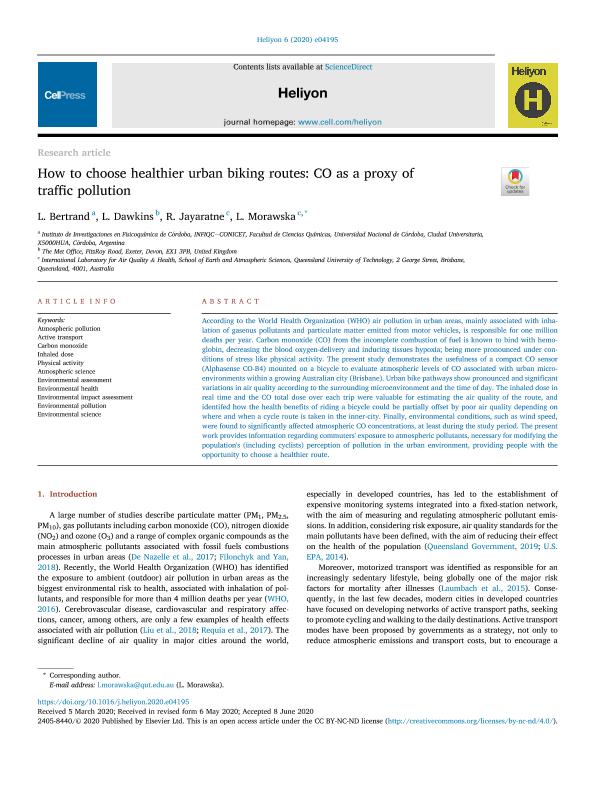Mostrar el registro sencillo del ítem
dc.contributor.author
Bertrand, Lidwina

dc.contributor.author
Dawkins, L.
dc.contributor.author
Jayaratne, R.
dc.contributor.author
Morawska, L.
dc.date.available
2021-11-16T16:30:20Z
dc.date.issued
2020-06
dc.identifier.citation
Bertrand, Lidwina; Dawkins, L.; Jayaratne, R.; Morawska, L.; How to choose healthier urban biking routes: CO as a proxy of traffic pollution; Elsevier Ltd; Heliyon; 6; 6; 6-2020; 1-9
dc.identifier.issn
2405-8440
dc.identifier.uri
http://hdl.handle.net/11336/146985
dc.description.abstract
According to the World Health Organization (WHO) air pollution in urban areas, mainly associated with inhalation of gaseous pollutants and particulate matter emitted from motor vehicles, is responsible for one million deaths per year. Carbon monoxide (CO) from the incomplete combustion of fuel is known to bind with hemoglobin, decreasing the blood oxygen-delivery and inducing tissues hypoxia; being more pronounced under conditions of stress like physical activity. The present study demonstrates the usefulness of a compact CO sensor (Alphasense CO-B4) mounted on a bicycle to evaluate atmospheric levels of CO associated with urban microenvironments within a growing Australian city (Brisbane). Urban bike pathways show pronounced and significant variations in air quality according to the surrounding microenvironment and the time of day. The inhaled dose in real time and the CO total dose over each trip were valuable for estimating the air quality of the route, and identifed how the health benefits of riding a bicycle could be partially offset by poor air quality depending on where and when a cycle route is taken in the inner-city. Finally, environmental conditions, such as wind speed, were found to significantly affected atmospheric CO concentrations, at least during the study period. The present work provides information regarding commuters' exposure to atmospheric pollutants, necessary for modifying the population's (including cyclists) perception of pollution in the urban environment, providing people with the opportunity to choose a healthier route.
dc.format
application/pdf
dc.language.iso
eng
dc.publisher
Elsevier Ltd
dc.rights
info:eu-repo/semantics/openAccess
dc.rights.uri
https://creativecommons.org/licenses/by-nc-sa/2.5/ar/
dc.subject
ACTIVE TRANSPORT
dc.subject
ATMOSPHERIC POLLUTION
dc.subject
ATMOSPHERIC SCIENCE
dc.subject
CARBON MONOXIDE
dc.subject
ENVIRONMENTAL ASSESSMENT
dc.subject
ENVIRONMENTAL HEALTH
dc.subject
ENVIRONMENTAL IMPACT ASSESSMENT
dc.subject
ENVIRONMENTAL POLLUTION
dc.subject
ENVIRONMENTAL SCIENCE
dc.subject
INHALED DOSE
dc.subject
PHYSICAL ACTIVITY
dc.subject.classification
Meteorología y Ciencias Atmosféricas

dc.subject.classification
Ciencias de la Tierra y relacionadas con el Medio Ambiente

dc.subject.classification
CIENCIAS NATURALES Y EXACTAS

dc.title
How to choose healthier urban biking routes: CO as a proxy of traffic pollution
dc.type
info:eu-repo/semantics/article
dc.type
info:ar-repo/semantics/artículo
dc.type
info:eu-repo/semantics/publishedVersion
dc.date.updated
2021-09-06T15:13:41Z
dc.journal.volume
6
dc.journal.number
6
dc.journal.pagination
1-9
dc.journal.pais
Países Bajos

dc.description.fil
Fil: Bertrand, Lidwina. Consejo Nacional de Investigaciones Científicas y Técnicas. Centro Científico Tecnológico Córdoba. Centro de Investigaciones en Bioquímica Clínica e Inmunología; Argentina
dc.description.fil
Fil: Dawkins, L.. The Met Office; Reino Unido
dc.description.fil
Fil: Jayaratne, R.. International Laboratory For Air Quality & Health, Qut; Australia. Queensland University of Technology; Australia
dc.description.fil
Fil: Morawska, L.. Queensland University of Technology; Australia. International Laboratory For Air Quality & Health, Qut; Australia
dc.journal.title
Heliyon
dc.relation.alternativeid
info:eu-repo/semantics/altIdentifier/url/https://linkinghub.elsevier.com/retrieve/pii/S2405844020310392
dc.relation.alternativeid
info:eu-repo/semantics/altIdentifier/doi/http://dx.doi.org/10.1016/j.heliyon.2020.e04195
Archivos asociados
